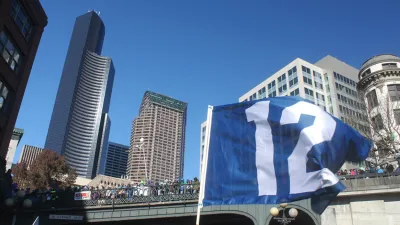Last Wednesday, an estimated 700,000—more than the city's population of 635,000—welcomed the Seahawks home, without major incident. Writing in The Atlantic Cities, Chuck Wolfe describes five lessons for placemaking through words and photographs.

 Wolfe provides an eyewitness summary of an event that brought an estimated 700,000 to downtown Seattle—more than the city's population of 635,000—without major incident.
Wolfe provides an eyewitness summary of an event that brought an estimated 700,000 to downtown Seattle—more than the city's population of 635,000—without major incident.
His thesis:
Efforts to create great urban places have a lot to learn from unifying regional events that cut across silos of culture, age, income, or neighborhood. Such events need not be limited to rebuilding after a superstorm or earthquake—they can be as simple and spontaneous as one city's celebration of its first-ever Super Bowl championship.
- Spontaneous, authentic "placemaking" with a purpose is often best.
- A robust, multimodal transportation network is key.
- A varied crowd of all ages makes a difference and can enhance a downtown core experience.
- One-time events can help crystallize potential alternative uses of urban spaces.
- We are more convertible than we think, and can avoid the politics and process that often inhibits great ideas.
He concludes with the optimism that ruled the day as a catalyst for urbanism going forward:
A center-city environment shared its spaces in the optimal fashion often sought by urban businesses, politicians, and residents, all without any of the usual endless debate and delay. For a day, I saw almost everyone happy, excited and with a common focus. Even if it was about professional football, that's really what good "urbanism" means.
FULL STORY: 5 'Placemaking' Lessons From Seattle's Amazing Super Bowl Parade

National Parks Layoffs Will Cause Communities to Lose Billions
Thousands of essential park workers were laid off this week, just before the busy spring break season.

Retro-silient?: America’s First “Eco-burb,” The Woodlands Turns 50
A master-planned community north of Houston offers lessons on green infrastructure and resilient design, but falls short of its founder’s lofty affordability and walkability goals.

Delivering for America Plan Will Downgrade Mail Service in at Least 49.5 Percent of Zip Codes
Republican and Democrat lawmakers criticize the plan for its disproportionate negative impact on rural communities.

Test News Post 1
This is a summary

Test News Headline 46
Test for the image on the front page.

Balancing Bombs and Butterflies: How the National Guard Protects a Rare Species
The National Guard at Fort Indiantown Gap uses GIS technology and land management strategies to balance military training with conservation efforts, ensuring the survival of the rare eastern regal fritillary butterfly.
Urban Design for Planners 1: Software Tools
This six-course series explores essential urban design concepts using open source software and equips planners with the tools they need to participate fully in the urban design process.
Planning for Universal Design
Learn the tools for implementing Universal Design in planning regulations.
EMC Planning Group, Inc.
Planetizen
Planetizen
Mpact (formerly Rail~Volution)
Great Falls Development Authority, Inc.
HUDs Office of Policy Development and Research
NYU Wagner Graduate School of Public Service



























